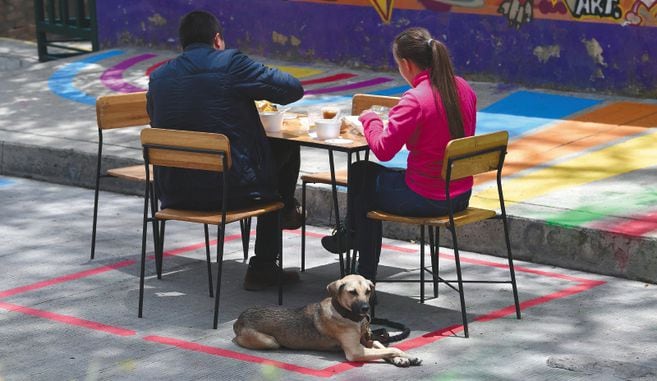July 9, 2021 – 2:04 a.m. subway.
With the total reopening, the public space becomes the protagonist to guarantee self-care measures. Although the controversy has centered on the value of its use, the decree that regulates it also speaks of revitalization and the rights of pedestrians, artists and street vendors.
The new decree that regulates the use of public space under the “A Cielo Abierto 2.0” model has generated controversy. Although it establishes conditions to improve the areas, as well as recognizes the right of pedestrians and street and informal vendors, the charge for their use does not quite convince everyone, given the current conditions of the pandemic and the cessation of activities in the sector in the last year.
As such, the decree indicates that the use of the space must be accompanied by the periodic maintenance of the platforms and roads, so it associates its use with an economic or in-kind remuneration (works in parks and avenues) by the merchants of restaurants and Food trucks that are part of the model.
For this, conditions are established such as the inclusion of people in vulnerable conditions, disabled or members of an ethnic group, and requires that the proposals for land use include a space for artists and informal vendors, so it will not be allowed the obstruction of the passage to the pedestrians by the zone nor the restrictive closings or entrance controls in the zones.
In addition to this, two scenarios are presented, that of merchants who present a proposal in a group or those who do it individually. In the first case, the District gives the option that, together, they make the remuneration in kind, that is, with the repair and maintenance of the streets used. For those who present themselves individually, payment in money is only allowed.
The cost depends on variables, such as the public space that is used, the time of day that it is used, the number of tables and implements that it installs and the average rent in the sector that is proposed. It also has other factors, such as a 20% discount on the remuneration for administrative expenses (logistics and administrator of the area) and another of $ 300,000 (30% of an SMLV) for linking people in vulnerability to the project.
Beyond how and when this remuneration model comes into operation, the issue opened a debate on how healthy charging for its exploitation is for the economy and public space. There are those who consider that it is necessary and can be a good source of income for the city, such as councilor Diego Laserna (Alianza Verde), who defends the project arguing that although this year it should not be charged, it must be done later to ” not giving public space to the first person who asks for it. In addition, this way you can find a healthy point where you don’t rent too much ”.
There are also voices, such as those of Fenalco and merchants, who consider that it is not the time to make a payment, since not a semester has passed since the reactivation of the sector began and they are barely recovering from the losses of the pandemic year . To this position was added the lobbyist Diana Diago (Democratic Center), who asked to respect the business sector, “because it generates employment and in a few months of reopening an economic recovery cannot be achieved.” Even, for the councilor, this sector should be the object of stimuli rather than charges.
Another vision of the proposal is that held by those who prioritize the public nature of the platforms, squares and avenues, which considers the idea as a policy of “privatization”. On this side of the debate are experts and councilors such as Manuel Sarmiento (Democratic Pole), for whom this would be a blow to those who sell on the streets, in a city with high levels of informality.
“This vision favors that establishments use public space, forgetting the situation of the workers. The public space must privilege the people who live off the scavenging and cannot be the object of privatization ”, assured Sarmiento. The argument that the project can lead to privatization is also defended from academia.
Mario Noriega, who for years taught urban planning classes and directed the master’s degree in that branch at the Javeriana University, explained that “paying for public space takes away its public character and turns it into a private business. This is not new and it is done in many cities, but it is necessary to study in which places to charge, how the public space is going to benefit, what activity is going to be done and if it makes sense to do it in the public space ”.
For academics it is a complex issue and, although it can be developed, they consider that many elements are being forgotten and that the proposal is a bit up in the air. Olga Ceballos, professor at the Faculty of Architecture and Design of La Javeriana, concluded that “it goes against the public principle of space and ultimately must take into account informal vendors”, as they will have double pressure to use the platforms.
Charging restaurants a tax for the use of platforms, front gardens and other spaces is an issue that touches several edges. It has benefits and damages, which will continue to be studied throughout this year, so that the project that starts in 2021 ends up being just as favorable for the District as it is for entrepreneurs in the gastronomic sector, as well as artists and informal vendors.





